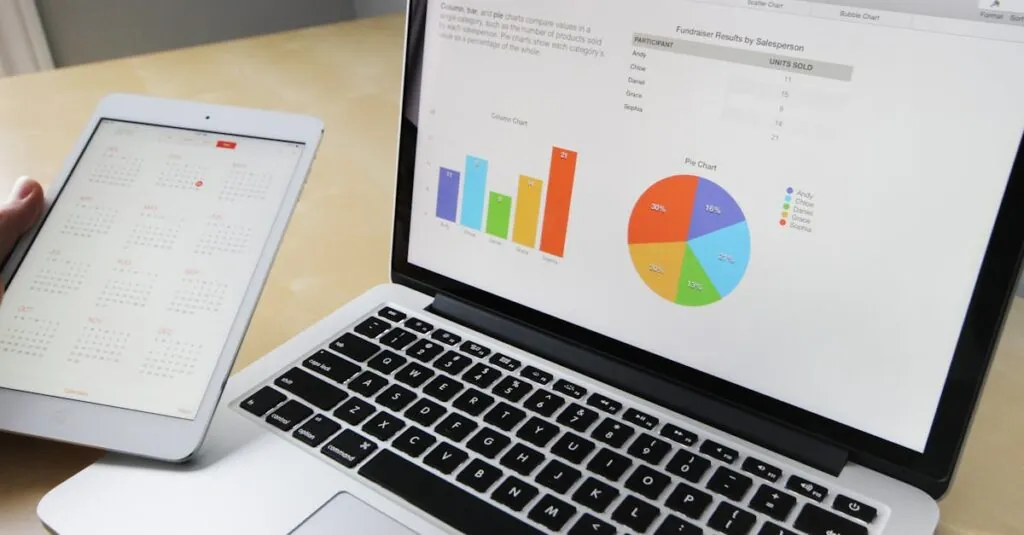Table of Contents
ToggleImagine a world where every transaction is as transparent as your favorite reality TV show, minus the drama. Welcome to the fascinating realm of blockchain workflow, where efficiency meets security in a digital dance that even the most seasoned techie would envy. This innovative technology isn’t just a buzzword; it’s the backbone of industries reshaping how businesses operate.
From supply chains to finance, blockchain workflow streamlines processes, cuts out the middleman, and leaves fraud in the dust. With its decentralized nature, it empowers organizations to collaborate like never before. So, buckle up and get ready to explore how blockchain workflow is not just changing the game, but rewriting the entire playbook. Who knew technology could be this thrilling?
Overview of Blockchain Workflow
Blockchain workflow streamlines processes through a decentralized network of computers. Each participant in the network maintains an identical copy of the blockchain, ensuring transparency. This architecture eliminates reliance on central authorities, reducing operational bottlenecks and enhancing trust among stakeholders.
Data consistency stands as a core principle of blockchain workflow. A transaction is recorded across multiple nodes simultaneously, making unauthorized changes nearly impossible. Smart contracts automate processes, executing transactions automatically when predetermined conditions are met. Their predefined rules enhance reliability and efficiency across industries.
Security measures further reinforce the integrity of blockchain workflow. Cryptographic algorithms safeguard data, preventing tampering and fraud. Unlike traditional systems, blockchain presents a tamper-resistant ledger that historians and auditors can trace back to its origin.
Collaboration thrives within blockchain environments. Organizations can share information seamlessly while maintaining control over their data. This collaborative aspect promotes innovation, enabling diverse parties to contribute without fear of data loss or breaches.
By tracking transactions in real time, blockchain allows for immediate visibility into operations. Monitoring and reporting become more effective, facilitating quick decision-making. Comprehensive audit trails provide accountability and transparency in all interactions, leading to increased stakeholder confidence.
In short, blockchain workflow enhances efficiency, security, and collaboration across diverse sectors. As businesses adapt to this technology, they can leverage the numerous benefits that blockchain offers, propelling them toward greater success.
Key Components of Blockchain Workflow
Blockchain workflow relies on several critical components that enhance its functionality. Two of these key components include smart contracts and decentralized applications (dApps).
Smart Contracts
Smart contracts play a vital role in automating transactions and processes. They function as self-executing contracts with specific agreements written directly into code. Upon meeting predefined conditions, these contracts execute automatically, ensuring efficiency and reliability. This automation reduces the need for intermediaries, lowering costs for all parties involved. Furthermore, smart contracts enhance accuracy by eliminating manual errors. Their transparency allows all stakeholders to verify transaction terms, fostering trust within the blockchain ecosystem.
Decentralized Applications (dApps)
Decentralized applications (dApps) capitalize on blockchain’s decentralized nature. They enable developers to create applications that run on peer-to-peer networks, offering increased security and resilience. dApps operate without a central authority, allowing users to maintain control over their data. These applications can range from finance to gaming, demonstrating flexibility across various sectors. By leveraging smart contracts, dApps can automate processes while providing real-time updates, ensuring a seamless user experience. The growing ecosystem of dApps further promotes innovation and collaboration, reflecting the potential of blockchain technology.
Benefits of Implementing Blockchain Workflow
Implementing blockchain workflow offers numerous advantages. Organizations experience enhanced transparency and security, increased efficiency, and significant cost reductions.
Transparency and Security
Transparency fosters trust among participants in a blockchain network. Each transaction appears on an immutable ledger accessible to all authorized users. Unauthorized changes become nearly impossible due to cryptographic safeguards, which protect data integrity. Users can trace the origin of each transaction, bolstering accountability. Security, enhanced by decentralized architecture, reduces vulnerabilities associated with traditional systems. Stakeholders can collaborate openly, knowing their data remains secure. This combination of transparency and robust security strengthens overall stakeholder relationships and encourages innovation.
Efficiency and Cost Reduction
Efficiency improves through streamlined processes enabled by blockchain. Organizations eliminate redundant tasks and reduce processing times significantly. Smart contracts automate transactions, ensuring faster execution without manual intervention. Instantaneous updates across the network minimize delays and errors, creating a more responsive environment. Cost reductions manifest as intermediaries become unnecessary, decreasing transaction fees and operational expenses. By enhancing efficiency and cutting costs, blockchain transforms how businesses operate, driving revenue growth and creating competitive advantages.
Challenges in Blockchain Workflow
Blockchain workflow faces several significant challenges that can impact its effectiveness and adoption across industries. Understanding these hurdles is essential for organizations seeking to leverage blockchain technology.
Scalability Issues
Scalability represents a primary concern within blockchain workflow. Current blockchain networks often struggle to handle high transaction volumes efficiently. For instance, as the number of users increases, transaction processing times can lengthen, leading to delays. Existing blockchains may process only a limited number of transactions per second, which can hinder real-time applications. Solutions like sharding and layer-2 protocols aim to address these scalability challenges. However, implementing these solutions requires careful planning and resources. Optimizing for scalability ensures blockchain can support widespread usage without sacrificing performance.
Regulatory Compliance
Regulatory compliance presents additional challenges for blockchain workflow. Various jurisdictions impose differing regulations that affect how blockchain solutions can operate. Organizations must navigate these complex legal landscapes to ensure compliance. Non-compliance can result in penalties that impact financial stability. Transparency and auditability are vital factors that blockchain can offer, but aligning them with existing regulations remains complex. Achieving compliance often requires collaboration with legal experts and continuous monitoring of evolving regulations. Consequently, understanding regulatory frameworks helps organizations mitigate risks and enhance their blockchain strategy effectively.
Future Trends in Blockchain Workflow
Emerging technologies are poised to reshape blockchain workflows significantly. Increased integration of artificial intelligence (AI) with blockchain enhances decision-making and optimizes operational efficiency. AI algorithms analyze vast data sets, offering actionable insights that enable organizations to fine-tune their strategies for greater impact.
In addition, the rise of interoperability among different blockchain systems is on the horizon. This shift allows various platforms to communicate effectively, streamlining operations across disparate networks. Seamless interaction fosters collaboration and broadens the application scope of blockchain technology across industries.
Moreover, the implementation of regulatory frameworks will likely influence blockchain workflow evolution. As governments establish clearer guidelines, organizations can adopt blockchain solutions with greater confidence. Compliance with regulations will become less cumbersome, easing friction in adoption and promoting wider acceptance.
Adoption of sustainable practices in blockchain technology is another emerging trend. Energy-efficient consensus mechanisms, such as proof of stake, reduce environmental impact while maintaining security. These innovations align with global efforts to enhance sustainability, appealing to environmentally conscious organizations.
Furthermore, non-fungible tokens (NFTs) are expanding the realm of blockchain applications. Various sectors, including art and entertainment, utilize NFTs to revolutionize ownership and provenance tracking. This approach fosters new revenue streams and enhances user engagement.
Finally, the continuing evolution of decentralized finance (DeFi) presents untapped opportunities. Applications in finance leverage blockchain to enhance transparency and reduce transaction costs. The focus now shifts to creating user-friendly interfaces that attract broader audiences and facilitate mass adoption of DeFi within the blockchain ecosystem.
Embracing blockchain workflow is essential for organizations aiming to thrive in today’s fast-paced digital landscape. By harnessing its capabilities, businesses can achieve greater efficiency and security while fostering collaboration across various sectors. The technology’s ability to streamline processes and enhance transparency positions it as a game-changer for industries facing operational challenges.
As organizations navigate the complexities of scalability and regulatory compliance, the potential for innovation remains vast. By staying informed on emerging trends and leveraging tools like smart contracts and dApps, businesses can unlock new opportunities. The future of blockchain workflow is bright, promising continued advancements that will reshape how organizations operate and interact in an increasingly interconnected world.







